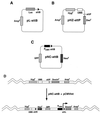Site-specific genomic integration in mammalian cells mediated by phage phiC31 integrase
- PMID: 11359900
- PMCID: PMC87055
- DOI: 10.1128/MCB.21.12.3926-3934.2001
Site-specific genomic integration in mammalian cells mediated by phage phiC31 integrase
Abstract
We previously established that the phage phiC31 integrase, a site-specific recombinase, mediates efficient integration in the human cell environment at attB and attP phage attachment sites on extrachromosomal vectors. We show here that phage attP sites inserted at various locations in human and mouse chromosomes serve as efficient targets for precise site-specific integration. Moreover, we characterize native "pseudo" attP sites in the human and mouse genomes that also mediate efficient integrase-mediated integration. These sites have partial sequence identity to attP. Such sites form naturally occurring targets for integration. This phage integrase-mediated reaction represents an effective site-specific integration system for higher cells and may be of value in gene therapy and other chromosome engineering strategies.
Figures



Similar articles
-
Integration specificity of phage phiC31 integrase in the human genome.J Mol Biol. 2006 Mar 17;357(1):28-48. doi: 10.1016/j.jmb.2005.11.098. Epub 2005 Dec 22. J Mol Biol. 2006. PMID: 16414067
-
Site-specific transgene integration in the human genome catalyzed by phiBT1 phage integrase.Hum Gene Ther. 2008 Feb;19(2):143-51. doi: 10.1089/hum.2007.110. Hum Gene Ther. 2008. Retraction in: Hum Gene Ther. 2010 Aug;21(8):1036. doi: 10.1089/hum.2010.1513. PMID: 18067406 Retracted.
-
PhiC31 integrase mediates integration in cultured synovial cells and enhances gene expression in rabbit joints.J Gene Med. 2006 Aug;8(8):1008-17. doi: 10.1002/jgm.928. J Gene Med. 2006. PMID: 16779871
-
[Progress of φC31 integrase system in site-specific integration].Yi Chuan. 2011 Jun;33(6):567-75. doi: 10.3724/sp.j.1005.2011.00567. Yi Chuan. 2011. PMID: 21684861 Review. Chinese.
-
Site-specific integration with phiC31 integrase for prolonged expression of therapeutic genes.Adv Genet. 2005;54:179-87. doi: 10.1016/S0065-2660(05)54008-2. Adv Genet. 2005. PMID: 16096012 Review.
Cited by
-
Genome-scale engineering for systems and synthetic biology.Mol Syst Biol. 2013;9:641. doi: 10.1038/msb.2012.66. Mol Syst Biol. 2013. PMID: 23340847 Free PMC article. Review.
-
Effect of nuclear localization and hydrodynamic delivery-induced cell division on phiC31 integrase activity.Gene Ther. 2010 Feb;17(2):217-26. doi: 10.1038/gt.2009.136. Epub 2009 Oct 22. Gene Ther. 2010. PMID: 19847205 Free PMC article.
-
Quantitative-enhancer-FACS-seq (QeFS) reveals epistatic interactions among motifs within transcriptional enhancers in developing Drosophila tissue.Genome Biol. 2021 Dec 20;22(1):348. doi: 10.1186/s13059-021-02574-x. Genome Biol. 2021. PMID: 34930411 Free PMC article.
-
Global mapping of binding sites for phic31 integrase in transgenic maden-darby bovine kidney cells using ChIP-seq.Hereditas. 2019 Jan 14;156:3. doi: 10.1186/s41065-018-0079-z. eCollection 2019. Hereditas. 2019. PMID: 30675136 Free PMC article.
-
Construction of a stepwise gene integration system by transient expression of actinophage R4 integrase in cyanobacterium Synechocystis sp. PCC 6803.Mol Genet Genomics. 2014 Aug;289(4):615-23. doi: 10.1007/s00438-014-0838-0. Epub 2014 Mar 18. Mol Genet Genomics. 2014. PMID: 24638932
References
-
- Anderson W F. Human gene therapy. Nature. 1998;392:25–30. - PubMed
-
- Capecchi M R. Altering the genome by homologous recombination. Science. 1989;244:1288–1292. - PubMed
-
- Feng Y Q, Seibler J, Alami R, Eisen A, Westerman K A, Leblouch P, Fiering S, Bouhassira E. Site-specific chromosomal integration in mammalian cells: highly efficient CRE recombinase-mediated cassette exchange. J Mol Biol. 1999;292:779–785. - PubMed
Publication types
MeSH terms
Substances
Grants and funding
LinkOut - more resources
Full Text Sources
Other Literature Sources
